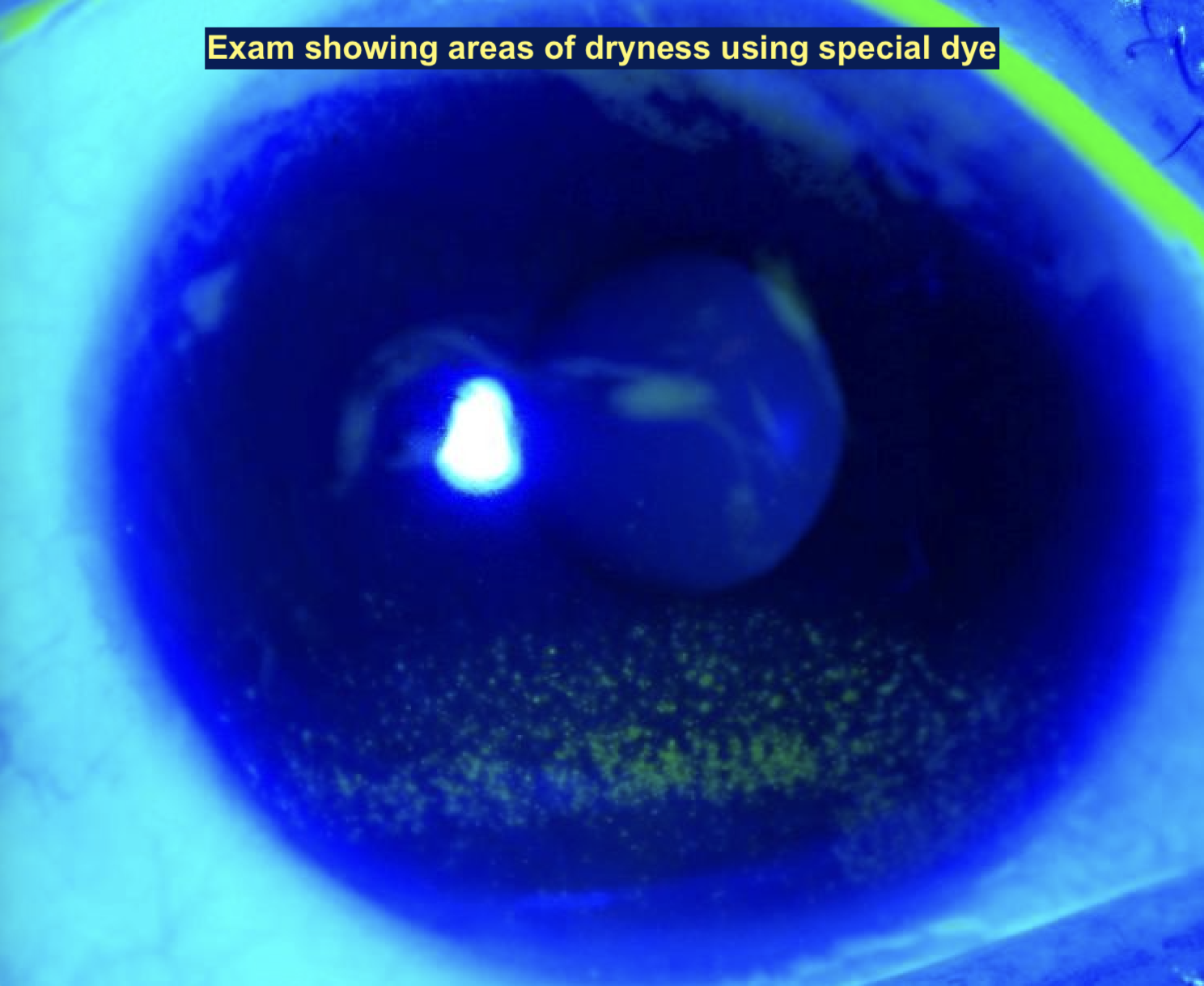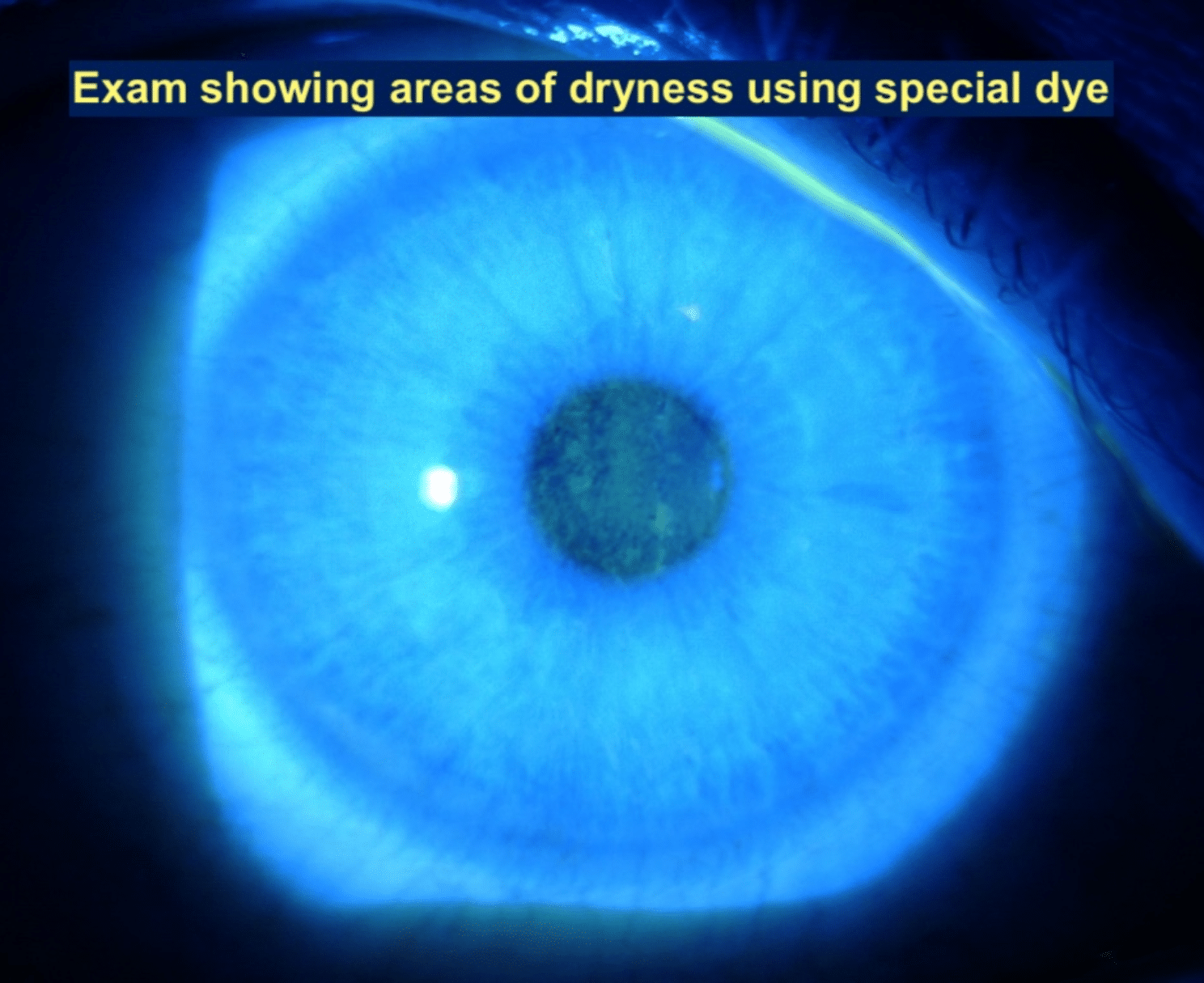What is Dry Eye Syndrome?
Dry eye syndrome occurs when your eyes do not produce enough tears or when the quality of your tears is poor, leading to discomfort, irritation, and sometimes vision problems. Tears are essential for keeping the surface of your eyes smooth and clear, maintaining eye health, and providing clear vision. The best way to diagnose dry eye is with a complete eye exam.


Symptoms of Dry Eye:
- Stinging or burning sensation in the eyes
- Itchy eyes
- Redness
- Sensitivity to light
- Blurred vision
- Eye fatigue
- Feeling like there's something in your eye
- Excessive tearing (a reflex response to the dryness
Causes of Dry Eye
- Aging: Tear production tends to decrease as you age
- Environmental factors: Dry or windy climates, air conditioning, and indoor heating can all contribute to dry eye symptoms.
- Computer use: Staring at a screen for extended periods can reduce blinking, leading to dry eyes.
- Medications: Certain medications, including antihistamines, decongestants, and antidepressants, can decrease tear production.
- Medical conditions: Conditions such as autoimmune diseases, diabetes, and thyroid disorders can contribute to dry eye symptoms.
- Long term contact lens use
- Eyelid surgery
Any of these factors, alone or in combination, can affect the frequency or consistency of tears, either of which can lead to dry eye.
Treatment of Dry Eye
Treatment for dry eye depends on its cause and severity, as well as the patient's overall health and personal preference.
Nonsurgical Treatments
Nonsurgical treatments, which include the following, are often effective:
- Deliberately blinking
- Increasing humidity levels at home or work
- Using artificial tears or a lubricating ointment
- Avoiding environmental irritants
- Eliminating medications that may be responsible
- Adding Omega-3 fatty acids to the diet or taking them as supplements
In many cases, simple lifestyle changes can alleviate dry-eye symptoms.
Surgical Treatments
If less invasive methods are unsuccessful, surgical treatments, which include the following, may be an option:
- Insertion of punctal plugs to limit tear drainage
- Punctal cautery to permanently close the drainage holes
- Treatment of an underlying disease
If an eyelid condition is causing dry eye, eyelid surgery may be recommended.
If dry eye is left untreated, it can lead to complications that include pain, corneal ulcers/scars or vision loss.
Preventing Dry Eye
There are steps that can be taken to prevent dry-eye symptoms. Simple lifestyle modifications such as wearing protective glasses on windy days, and giving the eyes a break during reading or other tasks that require intense focus, can effectively reduce the frequency and severity of symptoms.
Frequently Asked Questions (FAQ) – Dry Eye
1. What is dry eye?
Dry eye is a condition where your eyes do not produce enough tears, or the tears evaporate too quickly, leading to dryness, irritation, and discomfort.
2. What are the symptoms of dry eye?
Common symptoms of dry eye include:
- A gritty or sandy feeling in the eyes
- Burning or stinging sensations
- Redness in the eyes
- Blurry or fluctuating vision
- Sensitivity to light
- Excessive tearing (as a reflex to dryness)
- Difficulty wearing contact lenses
3. What causes dry eye?
Dry eye can be caused by a variety of factors, including:
- Insufficient tear production: Aging, hormonal changes (e.g., menopause), or medical conditions like diabetes or rheumatoid arthritis can reduce tear production.
- Increased tear evaporation: Environmental factors like dry air, wind, or smoke can cause tears to evaporate more quickly.
- Meibomian gland dysfunction: Problems with the glands in your eyelids that produce oil to stabilize the tear film can lead to dry eye. This is often referred to as blepharitis. Blepharitis can be related to inflammation or an infection (demodex) that can contribute to disfunction of their oil glands.
- Contact lens use: Long-term or improper contact lens wear can irritate the eyes and exacerbate dryness.
- Medications: Certain medications, like antihistamines, decongestants, and some antidepressants, can reduce tear production.
4. Who is at risk for dry eye?
People most at risk for dry eye include:
- Older adults, especially women (due to hormonal changes)
- Contact lens wearers
- People with certain health conditions (e.g., diabetes, autoimmune disorders, or thyroid issues)
- Those living in dry or windy climates
- People who use digital devices for extended periods (e.g., computer, phone)
- Pt with blepharitis (MGD or demodex related)
5. How is dry eye diagnosed?
Dry eye is diagnosed through an eye exam by an eye care professional. Tests may include:
- Schirmer test: Measures tear production.
- Tear breakup time: Checks how quickly the tear film evaporates.
- Fluorescein dye test: Helps detect damage to the surface of the eye and the quality of tears.
- Meibomian gland evaluation: Assesses the function of glands in the eyelids that produce oil for the tear film.
6. How is dry eye treated?
Treatment options for dry eye include:
- Artificial tears: Over-the-counter lubricating eye drops to relieve dryness.
- Prescription medications: Eye drops like Restasis or Xiidra can increase tear production and the quality of the tears. Patients with signs of blepharitis may respond to oral antibiotics like doxycycline or an eye drop that can treat a demodex infection (Xdemvy eyedrops).
- Punctal plugs: Small devices inserted into the tear ducts to prevent tears from draining too quickly.
- Warm compresses: Helps improve the function of oil-producing glands in the eyelids.
- Lifestyle changes: Reducing screen time, using a humidifier, and wearing sunglasses outdoors can help alleviate symptoms.
- Eyelid hygiene: Cleaning the eyelids to prevent blockages in the meibomian glands.
7. Can dry eye be prevented?
While dry eye may not always be preventable, you can reduce your risk by:
- Taking regular breaks when using digital devices (e.g., the 20-20-20 rule).
- Keeping your environment moist with a humidifier.
- Wearing sunglasses to protect your eyes from wind and dry air.
- Staying hydrated and avoiding smoking.
- Following good contact lens hygiene if you wear lenses.

